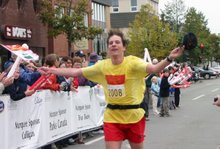 Stan Chaisson
Stan ChaissonRunning and walking can be intimidating for many, but if introduced gradually and
comfortably into your lifestyle it can be the outlet you need to keep in shape, enjoy the
outdoors, relax and relieve stress.
You don’t have to be an elite athlete to run or walk. Both are great sports because you are
able to go at your own pace. Programs can be designed for different levels whether you
are a competitor looking to qualify for the Boston Marathon or a beginner looking to
enter your first event. The upcoming Prince Edward Island Marathon weekend offers 7
different walking and running events and has something for every level of ability.
 As a trainer and as a runner I have learned the most important and the most overlooked
As a trainer and as a runner I have learned the most important and the most overlookedpiece of equipment are your shoes. In a recent meeting with the Guardian corporate team,
over half of the participants had wrong or worn out shoes. This is not uncommon and is
one of the leading reason people struggle or give up running all together.
So why is it so important to have the right shoes? Believe it or not, your feet strike the
ground a total of 1700 times per mile and each time you land your foot is absorbing four
times your body weight. You need to have the proper fit, cushioning and support to
absorb these forces properly and avoid injury. This can make the difference between
enjoying running or walking, or hating it, running in comfort or in pain, staying injuryfree
or suffering from aches and pains. You would never drive your car with worn out
tires or shocks, why put your joints and muscles through un-needed weight and pressure
by wearing wrong or worn out shoes?
How do you know what shoe you need? There are generally 3 different types of feet:
neutral, pronated or supinated. If you are biomechanically gifted you are one of the few
with a perfectly neutral foot. Your shoe requires a balanced combination of stability and
control components and each foot type requires a different level of each component to
properly fit.
People come in all shapes and sizes and so do their feet. It’s important to do your
homework before purchasing a new pair of running shoes to ensure you receive the most
suitable and comfortable shoe available to you, not just one that was on sale or matches
your outfit! Be sure to ask lots of questions when shopping for a new pair of sneakers.
A sales clerk should ask to see your old sneakers and check out the wear patterns or ask
you to stand on a foot disk to accurately measure your foot type before recommending a
shoe. If you are not confident they are accurately answering your questions, I highly
recommend seeing a physiotherapist for their advice. While this is a bit of an investment
in getting going, you can confidently head out the door for your run or walk knowing
you are properly outfitted and have the best chance of making it to the start and finish
line in October injury free.
Stanley Chaisson is a Certified Kinesiologist, trainer, avid runner and exercise enthusiast. Stanley will be
writing a series of weekly articles providing advice and training tips for those preparing for the BMO
Prince Edward Island Marathon weekend, October 18-19, 2008.





























No comments:
Post a Comment